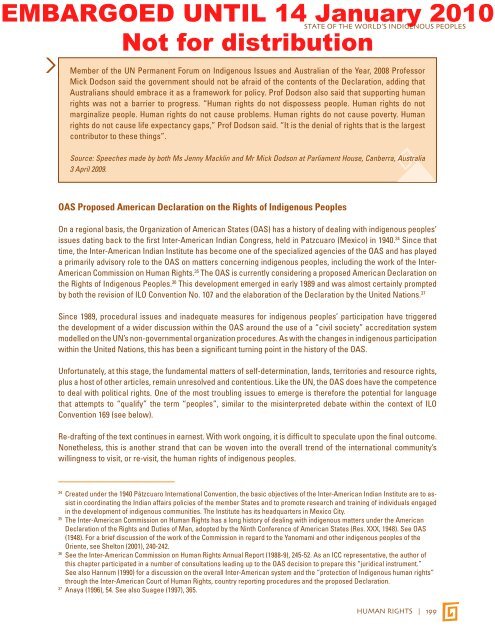STATE OF THE WORLD's INDIGENOUs PEOpLEs - CINU
STATE OF THE WORLD's INDIGENOUs PEOpLEs - CINU
STATE OF THE WORLD's INDIGENOUs PEOpLEs - CINU
- No tags were found...
Create successful ePaper yourself
Turn your PDF publications into a flip-book with our unique Google optimized e-Paper software.
EMBARGOED UNTIL 14 January 2010<strong>STATE</strong> <strong>OF</strong> <strong>THE</strong> WORLD’S INDIGENOUS PEOPLESNot for distributionMember of the UN Permanent Forum on Indigenous Issues and Australian of the Year, 2008 ProfessorMick Dodson said the government should not be afraid of the contents of the Declaration, adding thatAustralians should embrace it as a framework for policy. Prof Dodson also said that supporting humanrights was not a barrier to progress. “Human rights do not dispossess people. Human rights do notmarginalize people. Human rights do not cause problems. Human rights do not cause poverty. Humanrights do not cause life expectancy gaps,” Prof Dodson said. “It is the denial of rights that is the largestcontributor to these things”.Source: Speeches made by both Ms Jenny Macklin and Mr Mick Dodson at Parliament House, Canberra, Australia3 April 2009.OAS Proposed American Declaration on the Rights of Indigenous PeoplesOn a regional basis, the Organization of American States (OAS) has a history of dealing with indigenous peoples’issues dating back to the first Inter-American Indian Congress, held in Patzcuaro (Mexico) in 1940. 34 Since thattime, the Inter-American Indian Institute has become one of the specialized agencies of the OAS and has playeda primarily advisory role to the OAS on matters concerning indigenous peoples, including the work of the Inter-American Commission on Human Rights. 35 The OAS is currently considering a proposed American Declaration onthe Rights of Indigenous Peoples. 36 This development emerged in early 1989 and was almost certainly promptedby both the revision of ILO Convention No. 107 and the elaboration of the Declaration by the United Nations. 37Since 1989, procedural issues and inadequate measures for indigenous peoples’ participation have triggeredthe development of a wider discussion within the OAS around the use of a “civil society” accreditation systemmodelled on the UN’s non-governmental organization procedures. As with the changes in indigenous participationwithin the United Nations, this has been a significant turning point in the history of the OAS.Unfortunately, at this stage, the fundamental matters of self-determination, lands, territories and resource rights,plus a host of other articles, remain unresolved and contentious. Like the UN, the OAS does have the competenceto deal with political rights. One of the most troubling issues to emerge is therefore the potential for languagethat attempts to “qualify” the term “peoples”, similar to the misinterpreted debate within the context of ILOConvention 169 (see below).Re-drafting of the text continues in earnest. With work ongoing, it is difficult to speculate upon the final outcome.Nonetheless, this is another strand that can be woven into the overall trend of the international community’swillingness to visit, or re-visit, the human rights of indigenous peoples.34 Created under the 1940 Pátzcuaro International Convention, the basic objectives of the Inter-American Indian Institute are to assistin coordinating the Indian affairs policies of the member States and to promote research and training of individuals engagedin the development of indigenous communities. The Institute has its headquarters in Mexico City.35 The Inter-American Commission on Human Rights has a long history of dealing with indigenous matters under the AmericanDeclaration of the Rights and Duties of Man, adopted by the Ninth Conference of American States (Res. XXX, 1948). See OAS(1948). For a brief discussion of the work of the Commission in regard to the Yanomami and other indigenous peoples of theOriente, see Shelton (2001), 240-242.36 See the Inter-American Commission on Human Rights Annual Report (1988-9), 245-52. As an ICC representative, the author ofthis chapter participated in a number of consultations leading up to the OAS decision to prepare this “juridical instrument.”See also Hannum (1990) for a discussion on the overall Inter-American system and the “protection of Indigenous human rights”through the Inter-American Court of Human Rights, country reporting procedures and the proposed Declaration.37Anaya (1996), 54. See also Suagee (1997), 365.HUMAN RIGHTS | 199
















